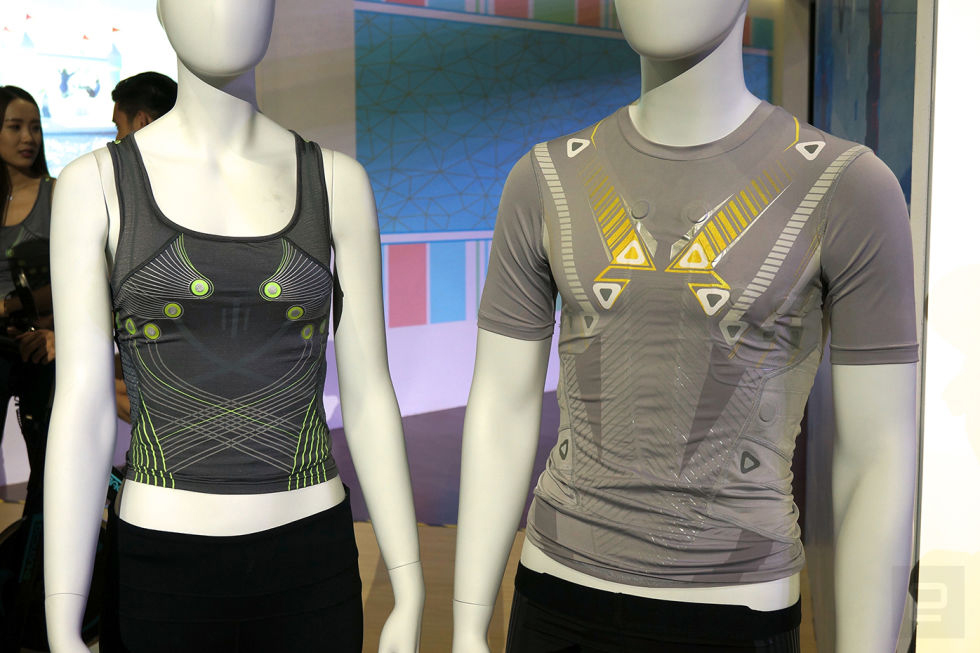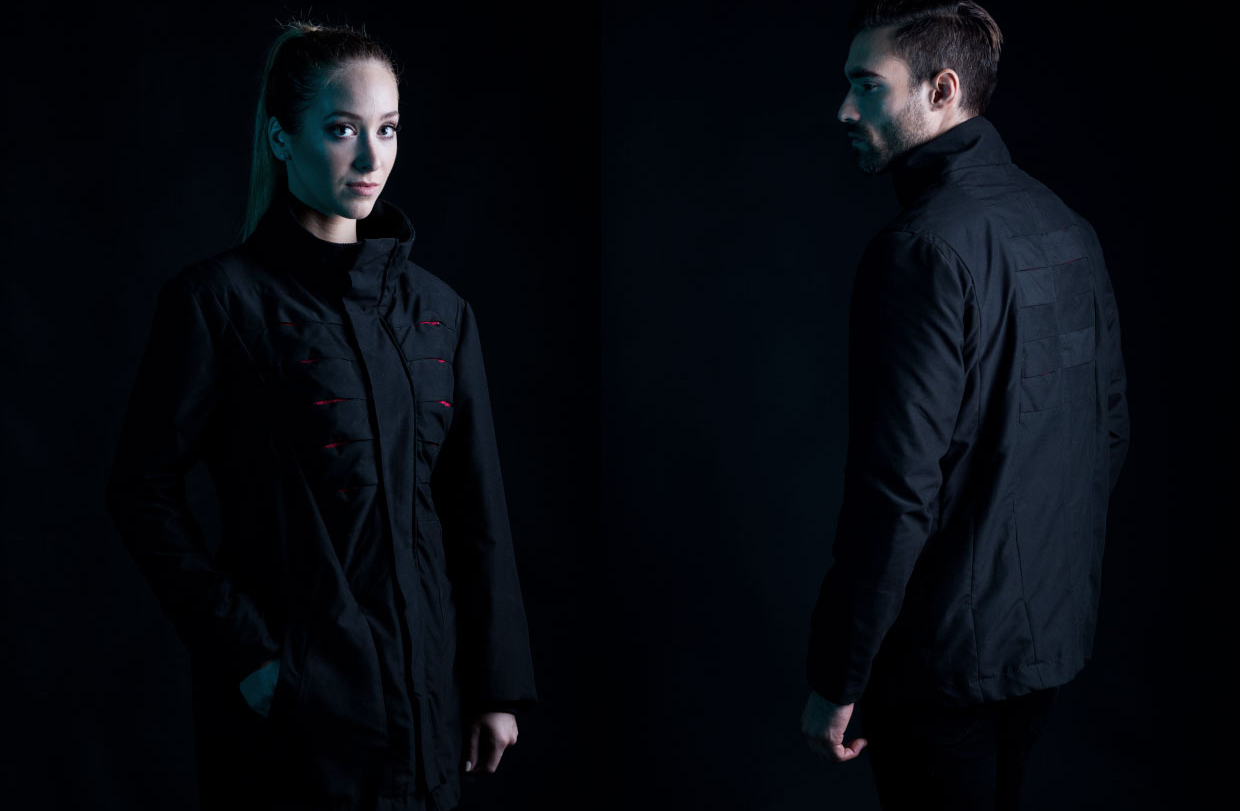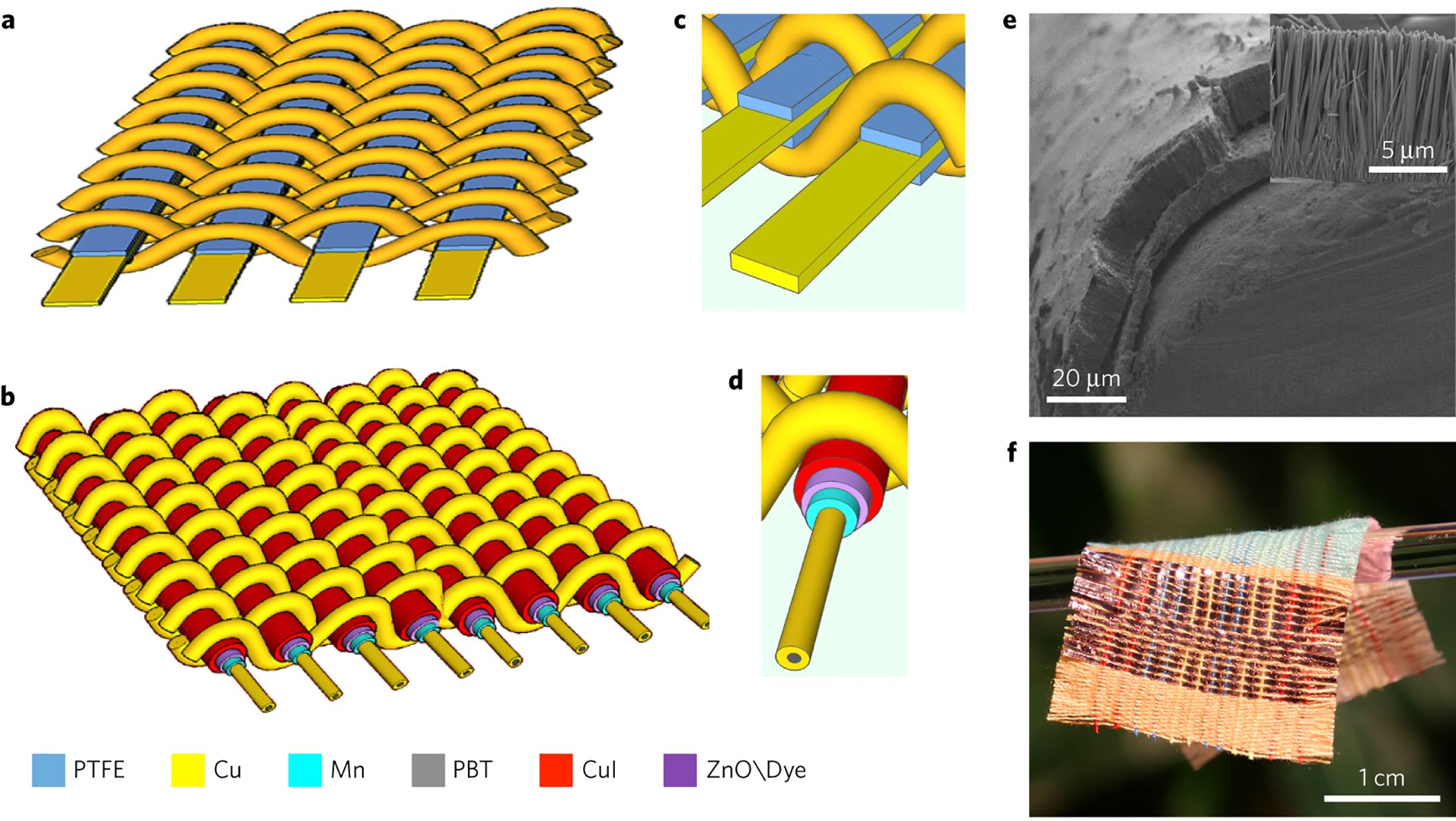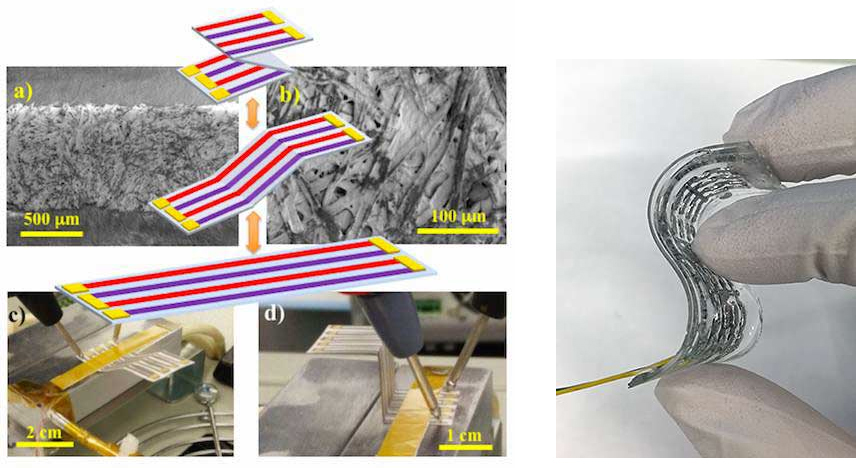Smart clothes of the future: is there potential?

Jacquard google jacket
Clothing is probably the next logical step in the evolution of gadgets. Just as smartphones once untied their users from desktops, jackets and t-shirts with electronic textiles can make the presence of a smartphone in your pocket completely unnecessary. Compared to any other device, clothing has several advantages. First, a large area, due to which it, for example, can be used as a solar panel. Secondly, it is always on you and adjacent to the body, which is useful for tracking heartbeats and other indicators.
From stationary computers we came to laptops, from laptops to smartphones, from smartphones to bracelets and smart watches. Now, many companies are asking - where to go next? And now Apple is filing a patent for "clothes connecting to electronics."
The industry has great prospects, and some curious “gadget things” have already been released. As usual, there are good ideas and some pancakes.
Successful (?) Options
Some "advanced" clothing is already for sale, and surprisingly, there are quite a few buyers for it. Starting from heated mittens that save your fingers, and ending with special swimsuits with UV sensors, warning sunbathers if they can soon get a sunburn. From the latest promising "gadget outfits" can be identified:
1. Blanc on Kickstarter raised $ 260 thousand for a heated jacket with charging for a smartphone. In March, already released, the full version costs $ 160 apiece. The device came up with two brothers-climber. It is cold in the mountains, you have to carry a pile of clothes with you. And when it gets warmer, you're sweating in this clothes. Now there is a universal option - a sweater, which can heat up with different intensity. Thanks to the carbon fiber system.

Besides - in this jacket there is a port for connecting a smartphone. The battery for heating is used quite capacious (5000 mAh), so why not recharge the smartphone in the process? In this case, the jacket can be easily washed, but, of course, you first need to remove the battery. Users seem to be very satisfied so far - especially considering the one-year warranty and the 30-day money-back guarantee, if they didn’t like something in the “clothes-gadget”.

')
2. At the end of 2018, Google and Levi's created a smart Jacquard jacket, which, for example, if you lose your smartphone, notifies its owner. This feature is called Always Together. It connects the smartphone and the smart jacket and sends the user a message if the distance between objects has greatly increased. For example, this can happen if the user leaves the smartphone on the bus.
When the phone is lost, the jacket sleeves start flashing and vibrating. The smart phone search feature is already built into the smart jacket, when activated, the smartphone starts ringing at full volume.

Developed by Google and Levi's also supports touch input, through which you can control music and navigator on your smartphone. The same input (on the sleeve) allows you to work with many other functions of smartphones with Android or iOS.
The cost of this jacket is $ 350 , it is sold in the online store Levi's. Ivan Pupyrev, Google’s Jacquard project manager, a couple of weeks ago at TED , managing his presentation from the jacket, said that in the future they were going to make this technology available to all clothing manufacturers.
3. And in China, meanwhile, in order to keep up, they created a “smart T-shirt” that will prevent a heart attack. Scientists from Lenovo and Southeast Jiangsu University have been involved in this project. Their clothes monitor the condition of the heart and warn the wearer about the first alarming symptoms.
Clothing called Smart Vest . It looks like a regular compression T-shirt, but it incorporates various wireless electrodes and sensors that monitor the ECG, recording heartbeat sounds, pressure and breathing for 24 hours continuously.
In addition, a special application is installed on the smartphone, which uploads all data to the cloud storage. Unloading occurs once a day, after which the T-shirt begins a new registration cycle.

Already in the repository, the artificial intelligence system analyzes the data and provides the result. In addition, the owners of smart clothes themselves can monitor the indicators of interest and send them to the doctor. One of the authors of the development, Dr. Liu Chengju, notes that the application can diagnose and even predict serious heart damage:
The best time to detect and treat a heart attack is 8 hours before cardiac arrest. But at the same time, the abnormal activity of the heart muscle becomes visible on the ECG 2-3 days before the attack. The system created by us is able to constantly monitor a person and warn him in case of danger. The T-shirt has already passed a series of tests on volunteers and has shown excellent results.
Koreans also try to keep up. They are working on the most promising technologies Samsung. Her secret lab, C-Lab, is developing, among other things, a belt informing you if you are starting to gain kilos, and a stylish business suit with NFC buttons hidden in the cuffs (useful for unlocking smartphones, turning on sound recording, exchanging digital business cards, work with projectors and other devices). Samsung also plans to release a golf shirt that tracks and corrects your shots, and a variety of different smart workout clothes.

Do not see anything unusual in a belt? There is a USB port here!
And Pizza Hut last year pushed its customers, firing smart sneakers that can order pizza and pause TV. Like, like, we know who our target audience is, and now you don’t even have to reach for the phone or the remote, sit and get fat.
Main Fails
The industry is at the very beginning of growth, and therefore almost every project can be said to be “promising”. It all depends on how to use and how to advertise the technology. But about some projects it is already clear that they have failed.
One of the worst options last summer introduced the fashion brand Tommy Hilfiger. "Smart clothes that nobody asked for." The American brand has released a series of Tommy Jeans Xplore, 23 items of clothing, from baseball caps to hoodie. Prices - one and a half times higher than usual, from $ 30 to $ 100. All this - for the chip with Bluetooth, which ... transmits information about your movement! Everything! This is all its functionality!

The idea of the company was that in this way it would create an “effective micro-community of ambassadors of our brand”. The chip will take into account the movement of customers, so the brand will see how often and how long people wear Tommy Hilfiger clothes. In which areas they live, how often they go to the "right" stores. And if you connect your clothes to the Tommy Jeans Xplore app, you will also gain points, as in some game. The more often you wear things of a brand, the more often you visit its stores - the more points you earn. As a result, these points can be spent on tickets to concerts, charity or discounts on other things brand.
Fine! But why do the users themselves need it? Useful functionality, as in the same Levi's Jaquard, here did not even try to implement. Accumulated bonuses do not interfere with the increased price of the purchased “clothes-device”. And most importantly - many expressed concern about the security of personal data about the movement of owners. Not everyone is comfortable to understand that some company knows where they are at any time. To which Tommy Hilfiger responded that the chip could be turned off if they wanted to. But then there will be no bonuses.
As a result, the product turned out to be one of the company's largest files. Up to the point that people never bought anything for their bonuses (they were accumulating too slowly to allow themselves anything). Less than a year has passed, but the products on the site are no longer sold, although the page has remained . The application on the App Store, necessary for the "launch" of jeans, also turned out to be a failure .

Another file, however, on a smaller scale, is the Omius Jacket air conditioning jacket. She had to feel and regulate your temperature, opening and closing microscopic pores in her tissue. So that you can freely enter from a cold street into a warm room, and then go back, and not even open your jacket. The functions there were still a whole box, not to list them all. And they promised a pleasant price: $ 99. True, it turned out that promising is much easier than actually doing something. The jacket Omius Jacket should have been launched in 2017, but it's still there .
It would be nice if such examples became lessons for the next generations of smart clothes. Because of the beneficial uses it can have the sea. And even the technology for this has recently appeared.
Future clothing potential
The main problem of “smart clothes” now is that the batteries and digital displays are still too heavy and not bending too well. Sticking them into clothes for everyday wear is not an easy task. Electronic textiles are heavy, uncomfortable, or too expensive to manufacture.
Thousands of researchers are now working on the creation of light and flexible matter, which would be sufficiently dense and stable, pleasing to the skin and could perform various useful tasks. Even the Google Jacquard jacket is recommended for only 10 wash cycles. If the “gadget clothing” comes into use, including bras, pants and socks, as many try to do, one must withstand much more washing cycles, plus at least a thousand hours of constant friction when worn.
As soon as this problem is resolved (and at a normal price), almost everything becomes possible. Some of the technologies needed to produce the clothes of the future are ready. It remains only to figure out how to put them into practice. The most promising developments are now going in six directions:
1. Change the design to the mood. Clothes can be changed as wallpaper on your smartphone. Just a matter of time. It will be possible to adjust to the weather, to the situation, to the mood. The same jacket is suitable for a romantic date, and for a business meeting, and for games in the yard (especially for the stash!). It will be possible to buy one thing, and walk in it at least every day, inventing more and more new color combinations.
This technology already exists: researchers from the University of Central Florida (UCF) in Orlando have created a fabric that changes color by clicking on a smartphone. Each strand contains copper wire in a polymer winding. The polymer can be nylon, polyester, or any other material, says one developer, Josh Kaufman. The weight of the product, however, is not yet suitable for the finest natures.
2. Keys and cards are always with you . Tired of checking everything with you when you leave the house? We must not forget the keys, including, for example, the bandwidth to work and the key to the entrance. Do not forget a bank card, subway map. Soon it will be possible not to worry about it. If you do not leave the house naked, then everything else you have with you too. In any pants or shirt can be stored enough information to pay for purchases in the supermarket or go to the subway.

Fabrics that can store passwords are now created using silver or copper. Usually, the magnetic poles of the atoms in these metal filaments are directed in random directions. But if you bring a magnet to the fabric, all the poles in this part of it are aligned, charging either negatively or positively. Magnetic atomic orientations store little data — ones or zeros — that a magnetometer can read.
3. Exact exercise. Clothes may teach you to hold a stick, play the piano, or just sit in the correct position. Sensors in the fabric directly on your body work much more accurately than the sensors on a fitness bracelet or the software in the camera that recorded your workouts on video. Smart clothes can feel your heartbeat, especially the movement of your hand, your posture. She understands where they put pressure on her more and less. There can be plenty of applications for this, not only in terms of training, but also in terms of assessing our health.

The material for this has already been developed - flexible motion sensors created from carbon nanotubes. Notice even the slightest tensile or compressive deformations, weighing no more than ordinary fabric. The nanotubes are about 50,000 times thinner than a human hair. The material is called buckypaper, a scientific article (PDF) can be read here about its first use in “smart clothes”.
Already there is even a finished product (albeit, created by a slightly different, coarser technology): Nadi X yoga pants, helping to get into the correct posture. They cost so far indecently expensive: $ 249.
4. Let there be light! The clothes of the future will be able to glow - a la "Tron: Legacy". It is already used in limited quantities - in some clothes for cyclists, which not only reflects, but also generates light, so that you can see clearly, including pedestrians on a dark street. But new technologies allow us to bring this idea to the next level.

Actress Claire Danes at the Met Gala costume ball in 2016 came in an evening dress decorated with LEDs. It looked gorgeous, photos still go around the Internet. But she had ordinary LEDs based on semiconductors. For everyday wear, they are not suitable: too fragile and tough. Seonil Kwon, a Korean engineer at KAIST in Daejeon, and his team developed a fabric that glows in the dark if you connect a battery to it. To do this, they use OLED - much more subtle and, as he says, reliable. OLED is usually placed on plastic or glass, but their organic LEDs, just 200 nanometers thick, are in a polyester film. That is laminated on the fabric made of the thinnest, but dense polyester fibers. It turns out even more flexible material than that used to make flexible displays.
5. Charging from the sun and muscles. After a whole day of work, it is unlikely that someone dreams, coming home, in turn to connect socks, pants, t-shirt, shirt and everything else for charging. Therefore, smart clothes need at least batteries, and ideally - a way to recharge, which does not depend on whether your friend has the right charger at home.
Here clothes have a big advantage over ordinary gadgets. A large area allows it to more efficiently collect solar energy. And the material near the knees, elbows, pelvis and shoulders can also be recharged from your movements. Scientists have already developed such a fabric. And it absorbs both types of energy simultaneously. One layer of this fabric has a thickness of only 320 microns, so that it can be integrated into any clothing, as well as into curtains, tents, and so on. A 4x5 cm piece of textile was able to charge a commercial 2 mF capacitor to 2 Volt in 1 minute. For this, he needed only the energy of the Sun - in the presence of mechanical pathogens, such as human movement and wind. According to scientists, their fabric can continuously power an electronic watch, recharge a smartphone or cause a water splitting reaction.

For the reception of solar energy are responsible more or less ordinary, only thin, semiconductors and photovoltaic wires, similar to those used in solar cells. And for the processing of the energy of motion into electricity, Teflon strips are responsible, well accepting electrons, intertwined with copper wires, which give electrons well. When the fabric shrinks or bends, some of the electrons from the copper flow into the Teflon strips, and the fabric produces electricity.
6. Walking generator . If you fill clothes with thermoelectric generators, even body heat can in theory be converted into electricity. Researchers from North Carolina State University are working on this. Their generators are about the size of a button. Each contains a grid of semiconductor rods sandwiched between two ceramic plates. If one plate (one side of the generator) is warmer than the other - say, if it is in contact with your skin - the electrons from the warm side of the rod begin to run to the cooler side, creating tiny tension. By connecting each positive end of the rod with the negative end of the next one, all these voltages can be summed, as when putting batteries in a flashlight, and to get something more or less significant.

Apple wants to join the development of smart clothes. In January of this year, a technogiant filed a patent for a “fabric-based product,” which can be connected to “electric devices”. Apple clothing will consist of a material in which there will be “conductive” and “insulating” fibers. Conductive filaments will be located in the inner layers of the weave and ensure the propagation of an electrical signal to all parts of such clothing. The outer layers of clothing will be made of insulating yarns to prevent any contact of the wearer's skin (or other people) with conductive fibers.
It is assumed that with such technology, Apple will create clothes that connect to the iPhone. She will inform her owner about his state of health, display the necessary information on the smartphone screen and play music using the built-in headphones. Apple usually takes at least several years from a patent to a real device, so smart clothes with the logo of a bitten apple, most likely, cannot be expected before 2021. But the main thing here is that if Apple is interested in something, other investors and experts will also soon turn their attention to it. So the jacket, freely changing its appearance, may already be just around the corner too.
PS It is profitable to deliver goods from online stores in the USA can Pochtoy.com. And we now sell your products in America’s stores (“ Fulfillment ” service). And we bring delicious sweet gifts in each package (“ Sweets ” service).

Source: https://habr.com/ru/post/455126/
All Articles